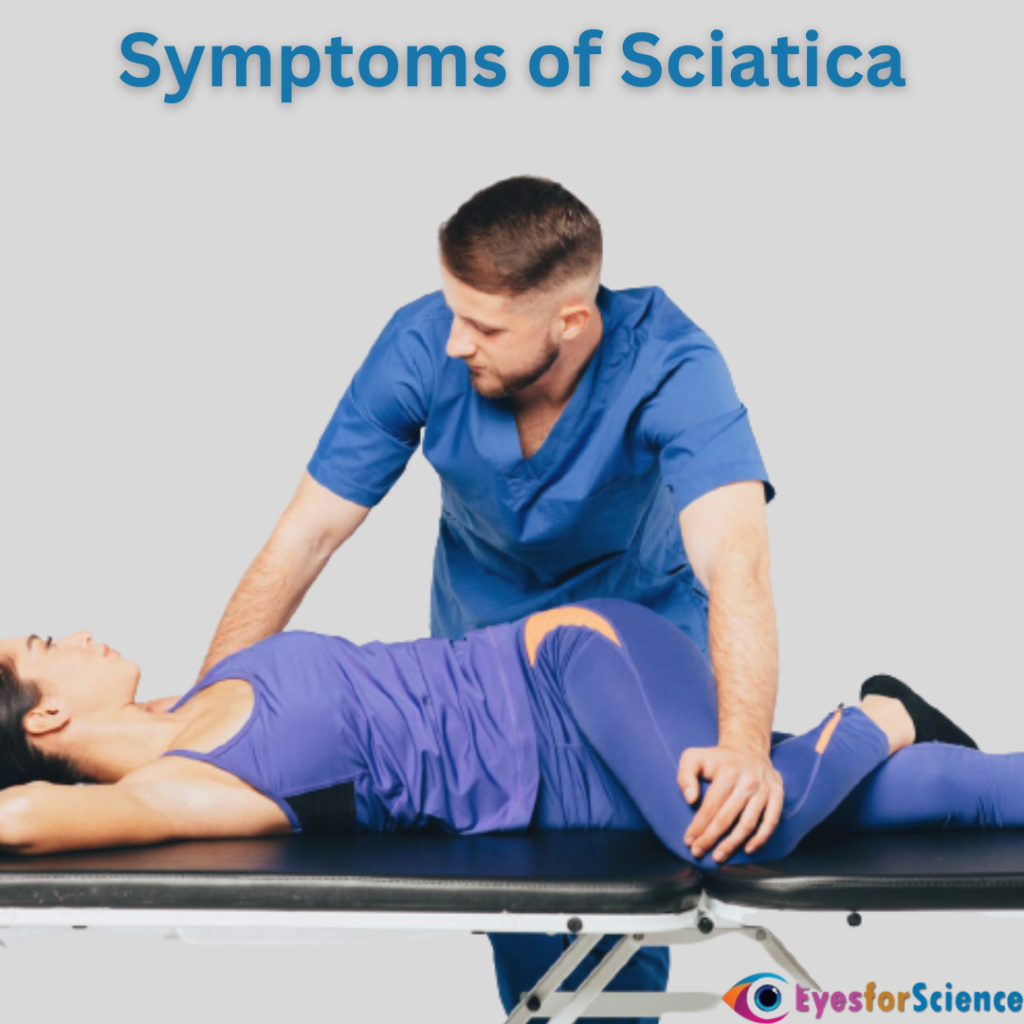What is Sciatica?
Sciatica is a term given to pain that travels from the lower back to the leg through the buttocks. In other words, sciatica is a condition in which pain travels through the sciatic nerve. This nerve (sciatic) passes from the lower back through the buttocks and hips down to both legs. Hence, pain occurring in the nerve is called sciatica.
A few of the common causes of sciatica include a herniated disc in the lower back or overgrowth of bone that puts pressure on the nerve. This results in numbness, pain, and inflammation in the affected leg. The intensity of the pain depends on the severity of the condition. Some cases of the condition may improve with medication whereas some may require surgical intervention.

What Are the Symptoms of Sciatica?
Pain is the common symptom of sciatica and it may occur anywhere along the path of the sciatic nerve. The path starts from the lower back and goes down to the legs. The intensity of the pain may vary from a mild ache to sharp shooting or burning pain. The sciatic pain can be worse while coughing and sneezing. The pain could also be intense after prolonged sitting or standing.
In most cases, sciatica affects only one side of the body.
What Are the Causes of Sciatica?
If we talk about the root cause of the condition, then it is the compression or damage to the sciatic nerve. Now, there are multiple reasons for the damage or compression of the nerve, some of which may include:
- A herniated disc, especially in the lower spine
- Degenerative disc disease
- Bone spurs
- Spinal stenosis
- A tumor that pinches the sciatic nerve
Risk Factors for Sciatica
Age
We cannot avoid age-related deterioration of bones and that is the major risk factor for sciatica. This is because with age, the risk of a herniated disc and bone spurs, are two of the common causes of sciatica.
Obesity
Being overweight puts stress on the spine and hence, increases the risk of nerve compression.
Occupational Activities
A job that requires frequent twisting of your back and heavy lifting also puts you at high risk of sciatica.
Prolonged Sitting
According to some studies, people who keep sitting in a place for a long tend to have a higher risk of developing sciatica than active individuals.
Diabetes
Diabetes affects the way of utilizing sugar by the body and this increases the risk of nerve damage.
What Are the Warning Signs of Sciatica?
In most cases, the body gives signals in the case of an unexpected event, and hence, in the case of sciatica as well, some warning signs are also there:
Sharp Pain
When the sciatic nerve is damaged or pinched, it starts causing shooting pain that radiates down along the path of the sciatic nerve. Pain may either be constant or intermittent.
Numbness
Pinching or damage to the sciatic nerve often results in numbness in that area. Thus, in the case of sciatica, you may experience numbness in the lower back, buttocks, or legs.
Gradual Muscle Weakness
Muscle weakness over time is likely in people with sciatica, as in this condition, your activity becomes limited and hence, gradual weakness in the muscles starts to occur. Weakness could be severe enough that you won’t be able to walk or stand properly.
High-Intensity Pain While Sitting
In some cases, the nerve damage is severe enough that it will be difficult for you to sit because of the pain.
What is the Diagnosis of Sciatica?
A physical examination is the first step during the diagnosis of sciatica. Here, the healthcare service provider looks for muscle strength and range of motion. Besides this, the doctor will also ask the patient to make some movements like walking on toes or heels, squatting, or lifting legs to notice painful movements. Besides this, diagnostic tests can confirm the condition. The tests ordered may include:
X-ray – It can detect overgrowth of the bone which is pressing the nerve.
MRI – MRI depicts pinched nerve and herniated disc.
CT Scan – The doctor may inject a dye into the spinal canal before the test and that may help produce better and clearer images.
Electromyography (EMG) – It identifies the severity of the nerve root injury.
What is the Treatment of Sciatica?
The treatment of sciatica depends on the severity of the condition. In mild cases, the condition improves with medication and physiotherapy.
The medicines ordered may include:
- Anti-inflammatory drugs
- Anti-depressants
- Corticosteroids
- Opioids
- Anti-seizure medications
After the pain improves with medicines, the doctor will suggest targeted physical therapy to improve the range of motion and strengthen the area to prevent future injuries.
If oral drugs do not provide relief, the doctor will prescribe steroid injections directly to the nerve. In most cases, one injection is enough to curb pain but if not, the doctor can give at max three in a year.
Surgery
Surgery is the last option in severe cases, and when no other methods are able to provide relief. Especially, it is done to remove bone spurs or fix a herniated disc. The doctor may also suggest surgery when sciatica causes severe pain and weakness along with loss of bowel or bladder control.
How to Prevent Sciatica?
Sciatica cannot be prevented every time but still, certain measures can be adopted to minimize the risk and even complications. Here’s what you should do:
Regular Exercise
Regular exercising is a part of a healthy routine and a healthy body. If talk in the context of preventing sciatica, then it is important to focus on strengthening your core back muscles to keep the back in good posture and alignment. If you don’t know which exercises you should do, seek a professional’s help.
Maintain Good Posture
When it comes to preventing back injuries or problems, maintaining a good posture throughout the day is important. If you have a sitting job, then you must choose a seat with a firm back support and maintain an upright position while sitting. Don’t forget to stretch your back and legs a bit after every 2-3 hours. Keep the knees bent at 90 degrees and both feet completely on the ground.
Don’t Overstress Your Body
This is an important tip to prevent not only sciatica but other spinal conditions as well. Do not excessively push the ability of your body to do a particular work. For example, if your body’s ability is t lift 30 kilos do not try lifting an object of 60 kilos suddenly. This can break your back down and more severe injuries could occur. whatever you do, know your limits, and give enough rest to your body periodically.
Another important tip is not to lift and twist at the same time.
Non-Surgical Approaches to Prevent Sciatica and Promote Spinal Health
Exercise and Physical Activity
Regular exercise is paramount in preventing sciatica. Focus on activities that strengthen the core muscles, such as yoga, Pilates, and targeted stretching routines. These exercises enhance flexibility, improve posture, and reduce the likelihood of nerve compression.
Maintain a Healthy Weight
Excess body weight can exert pressure on the spine, increasing the risk of sciatica. Maintaining a healthy weight through a balanced diet and regular exercise not only prevents obesity-related complications but also reduces strain on the spine.
Ergonomic Practices
Poor posture and extended periods of sitting contribute to sciatica. Employing ergonomic practices at work and home, such as using supportive chairs, maintaining a neutral spine position, and taking breaks to stretch, can significantly reduce the risk of developing sciatic nerve issues.
Stay Hydrated
Proper hydration is crucial for spinal health. Water helps maintain the spinal discs’ integrity, preventing dehydration that can lead to reduced disc height and increased susceptibility to nerve compression.
Quit Smoking
Smoking has been linked to increased disc degeneration and decreased blood supply to spinal tissues. Quitting smoking not only benefits overall health but also plays a crucial role in preventing sciatica.
Appropriate Lifting Techniques
Incorrect lifting techniques can strain the spine and lead to sciatica. Always bend at the knees, keep the back straight, and lift with the legs to minimize the risk of injury to the lower back.
Regular Chiropractic Care
Chiropractic adjustments can help maintain proper spinal alignment, reducing the likelihood of nerve impingement. Regular visits to a chiropractor may alleviate existing discomfort and prevent future episodes of sciatica.
By incorporating these non-surgical approaches into daily life, individuals can take proactive measures to prevent sciatica, foster spinal health, and enjoy a more active and pain-free lifestyle. Always consult with healthcare professionals before starting any new exercise or health regimen.








